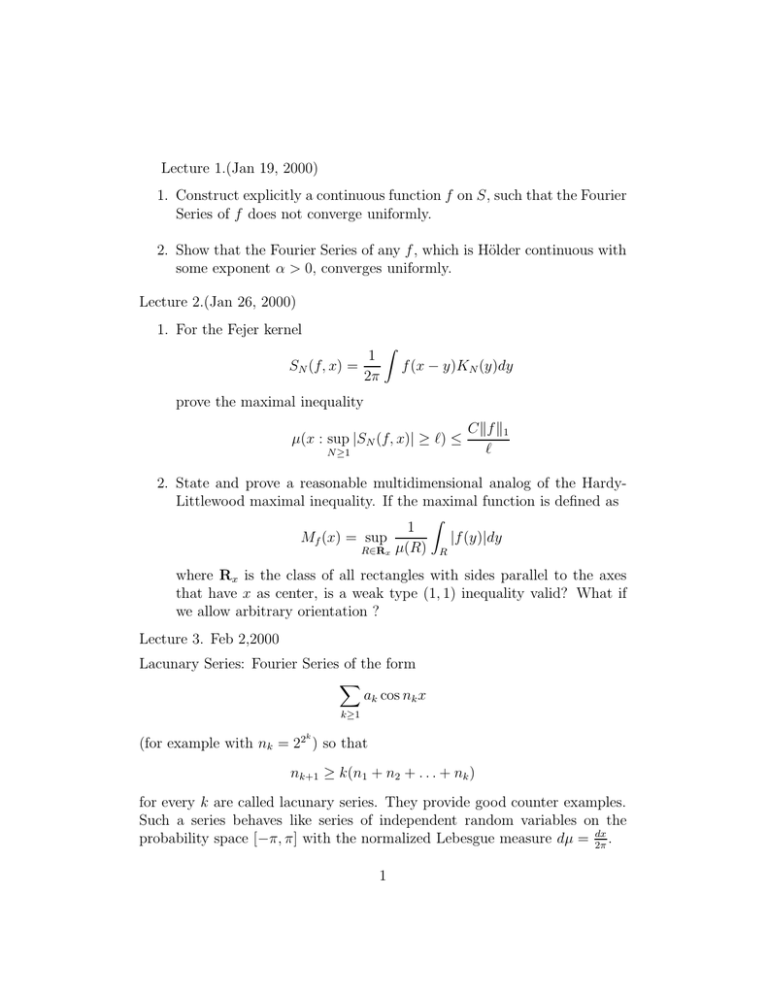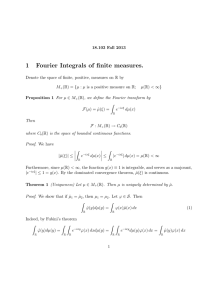Lecture 1.(Jan 19, 2000) f α > Lecture 2.(Jan 26, 2000)
advertisement

Lecture 1.(Jan 19, 2000)
1. Construct explicitly a continuous function f on S, such that the Fourier
Series of f does not converge uniformly.
2. Show that the Fourier Series of any f , which is Hölder continuous with
some exponent α > 0, converges uniformly.
Lecture 2.(Jan 26, 2000)
1. For the Fejer kernel
1
SN (f, x) =
2π
Z
f (x − y)KN (y)dy
prove the maximal inequality
µ(x : sup |SN (f, x)| ≥ `) ≤
N ≥1
Ckf k1
`
2. State and prove a reasonable multidimensional analog of the HardyLittlewood maximal inequality. If the maximal function is defined as
Z
1
Mf (x) = sup
|f (y)|dy
R∈Rx µ(R) R
where Rx is the class of all rectangles with sides parallel to the axes
that have x as center, is a weak type (1, 1) inequality valid? What if
we allow arbitrary orientation ?
Lecture 3. Feb 2,2000
Lacunary Series: Fourier Series of the form
X
ak cos nk x
k≥1
k
(for example with nk = 22 ) so that
nk+1 ≥ k(n1 + n2 + . . . + nk )
for every k are called lacunary series. They provide good counter examples.
Such a series behaves like series of independent random variables on the
dx
probability space [−π, π] with the normalized Lebesgue measure dµ = 2π
.
1
1. On the probability space of [−π, π] with normalized Lebesgue measure
dx
prove the central limit theorem for the random variables
2π
r
SN =
N
2 X
cos nj x
N j=1
by calculating the moments and showing that for every k ≥ 1,
Z π
Z ∞
1
1
y2
k
lim
[SN (x)] dx = √
y k exp[− ]dy
N →∞ 2π −π
2
2π −∞
2. Construct a sequence of functions
X
fk (x) =
ak,n ei n x
n
such that
lim
k→∞
X
|ak,n |p = 0
n
for every p > 2 while for every ` > 0
lim µ[x : |fk (x)| ≥ `] = 1
k→∞
so that fk does not go to 0, in any reasonable space of functions.
Lecture 4, Feb 9, 2000
1. Suppose we have in the plane, a function K(x, y) of the form K(θ)
in
r2
polar coordinates. Assume that K(θ) is a nice periodic function of
R 2π
period 2π that has mean 0, i.e 0 K(θ)dθ = 0. Compute its Fourier
transform
Z
k(ξ, η) =
exp[i(ξx + ηy)]K(x, y)dxdy
R2
and show that it is a homogeneous function of degree 0.
2. Consider the following class of operators on R2
Tcf = k(θ)fˆ
2
where fˆ is the fourier transform of f and θ is the angle in the polar
coordinates (r, θ). Find a representation for T , as a convolution with
a kernel K(x, y) of the type considered in problem 1. Find reasonable
sufficient conditions on k, under which T is a bounded operator from
Lp to Lp for 1 < p < ∞.
3. Is there a generalization to Rd for d > 2?
Lecture 4 Feb 16, 2000.
Q 1. Let u ∈ Wk,p for some positive integer k and 1 < p < ∞. if we define
the translations Ti,h by
Ti,h u = u(x1 , . . . , xi−1 , xi + h, xi+1 , . . . , xd )
show that the limits of difference quotients
1
Dxi u = lim [Ti,h u − u]
h→0 h
exist in Wk−1,p and define a bounded operator Dxi from Wk,p , into Wk−1,p
Q 2. Let d = 1 and u(x) ∈ W1,1 Show that u is continuous at every x and
differentiable in the usual sense at almost all x, i.e for almost all x,
u(x + h) − u(x)
= (Du)(x)
h→0
h
lim
Lectures 5-6
March 1, 2000
Q 1. Suppose f is given by a rational function
f (ei θ ) =
|P (ei θ )|2
|Q(ei θ )|2
where P and Q are polynomials and Q has no zeros on the unit circle. Calculate the projection of 1 on the span of {ei kθ : k ≥ 1} and the projection
error.
Q 2. If
Z
0
2π
log f (θ)dθ = −∞
3
show that Hk = Hk+1 for every k.
Q 3. Can you show that if µ ⊥ dθ then again Hk = Hk+1 for all k?
Lectures 7
March 8, 2000
Q 1. Show that the function log |x − y| is a BMO function of x for each y.
Q 2. What about
Z
U(x) =
log |x − y|dµ(y)
for some finite measure µ.
Q 3. A function u(x) is said to be in the class VMO (Vanishing mean
oscillation) if
Z
1
lim sup
|u(x) − uQ |dx = 0
h→0 Q:|Q|≤h |Q| Q
Can you find a function that is BMO but not VMO?
Can you find a function that is VMO but not continuous?
4


![MA342A (Harmonic Analysis 1) Tutorial sheet 8 [December 10, 2015] Name: Solutions √](http://s2.studylib.net/store/data/010415901_1-00035e0c3b9d31c812df276d6fe8c92d-300x300.png)

